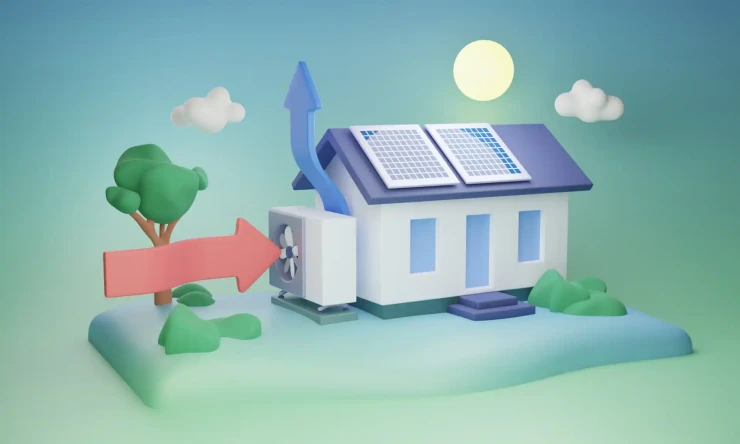
One of the most trending fields of merging sustainability with science has been to explore methods of generating and popularising the usage of renewable energy. This can be achieved only through a significant decrease of mankind’s dependence on non-renewable energy sources, while simultaneously reducing the negative points of impact on an individual level, no matter how minimal they seem. The change starts with you and when it comes to preserving the environment, there is no better place to start with, rather than your own home. Using naturally replenishing resources can cause a major decline in the release of harmful pollutants infesting your surroundings everyday. Some of the well-known categories of renewable energy sources include solar energy, wind energy, hydropower, geothermal energy, and biomass energy. Each of these energy sources has unique benefits and challenges, and understanding them is crucial to building a more sustainable and resilient energy system inside out.
Benefits of Encouraging the use of Renewable Energy:
Renewable power sources have a wide range of benefits that make them a compelling alternative to non-renewable sources like coal, oil, and natural gas. Firstly, sustainable power sources are naturally replenished, making them a perpetual and dependable source of energy over the long haul with minimal ecological effect, as they do not release harmful pollutants into the environment which might alter climate’s ideal conditions, leading to climate change. This means that using sustainable power sources can help reduce greenhouse gas emissions and mitigate the impacts of climate change while protecting public health.
COMPARE PRICES FROM LOCAL INSTALLERS
Compare prices from local companies fast & free
Enter your postcode to compare quotes from leading professionals. We promise to keep your information Safe & Secure. Privacy Policy
Sustainable energy systems are also more cost-effective over the long term, despite requiring a greater initial investment than non-renewable power sources as the former generally demands lower operational and maintenance costs. The amount of initial investment is also lowering down with time as the technology becomes more accessible to the general public. According to a report from the International Energy Agency (IEA), renewable energy sources have become the second-largest source of electricity generation worldwide, accounting for 28% of the global electricity mix in 2020. The report also notes that renewable energy capacity increased by 45% between 2010 and 2020, with wind and solar energy leading the way. In the United States, renewable energy sources accounted for 21% of total electricity generation in 2020, with solar energy growing by 25% and wind energy growing by 14% over the previous year.
The renewable energy generating systems can often be decentralised, allowing for greater energy independence and resilience in the face of power outages or other disruptions, which can be particularly important in remote or rural areas having significantly lesser access to traditional power sources. It should also be noted that the sustainable power sector is a thriving industry, with enough potential to generate employment opportunities by getting incorporated into unconventional fields of work like architecture and transport as these systems require installation, maintenance, and other services, creating opportunities in the face of adversity and unemployment.
Types of Renewable Energy Sources and their Viability:
One of the most urgent issues facing the world today is the need for various options when it comes to utilising renewable energy sources so that the drive for sustainability does not get limited to only certain geographical parameters being fulfilled. Fortunately, there are several types of renewable energy sources that have become more accessible and affordable in recent years, thanks to innovative technological advancements.
- Solar energy and wind energy are two of the most prominent examples of renewable energy sources that have a wide range of utility and benefits. Solar energy harnesses the power of sunlight to generate electricity, heat water and air, and even charge electric vehicles using Photovoltaic panels, which are the main devices that convert sunlight into electricity, and they can be installed on rooftops, fields, or even floating platforms. Installing these in areas which receive the maximum amount of sunlight would prove optimal in terms of sustainability.
Wind energy utilises the power of wind to generate electricity, pump water, and perform other mechanical tasks, making it a great alternative to solar energy for places which do not get much period of due sunlight. Wind turbines capture wind and convert it into electricity, these can be erected on land or offshore, making it a clean and sustainable source of energy that produces no greenhouse gas emissions or air pollutants.
- Another type of renewable energy source that has been widely used for a long time is hydroelectric energy, which uses the force of water to generate electricity. Water flows through turbines in dams or other structures, creating electricity that can power homes, businesses, and even entire countries. It can also help with water management and irrigation, making it useful for agriculture and other sectors. Although, it should be noted that it is not entirely harmless as it can also have negative environmental impacts by disrupting natural water flows and harming fish populations.
- A newer type of renewable energy source that has gained more attention in recent years is geothermal energy, which. Geothermal energy uses the heat from the Earth’s core to generate electricity or heat which can heat homes and buildings, produce electricity, and even support industrial activities such as food processing and mineral extraction. Geothermal energy is a reliable source but it is not widely available, as it requires specific geological conditions to be viable.
- On the other hand, a widely available energy source which can be derived from various organic sources is biomass energy, using organic matter such as wood, crops, and agricultural waste to generate electricity or heat. It can be used to heat homes and buildings, produce electricity, and even fuel transportation. On a smaller level, biomass energy can also provide fuel for cooking and other household tasks in developing countries. However, biomass energy can have significant environmental impacts if not managed sustainably, such as causing deforestation and increasing carbon emissions.
- Tidal Energy, another renewable source has emerged to prominent usage in the recent year by using the movement of tides to generate electricity. This energy can be used to power the entire community residing in coastal areas. Tidal energy is a predictable and reliable energy source, as it depends on the natural cycle of the moon and the sun but its availability still remains limited, as it requires specific tidal conditions to be viable.
Ways to Explore at-home Utilisation of Renewable Energy:
Waiting for large industries to implement change in the fight against climate change can feel like waiting for a snail to complete a marathon. However, as individuals, we possess the power to make a significant impact in the battle against environmental degradation by embracing renewable energy sources within our own homes. Rather than waiting for behemoth corporations to shift their practices, we can take proactive steps to reduce our reliance on unsustainable, non-renewable energy sources and embrace cleaner, more sustainable alternatives. Though the prospect of implementing renewable energy systems in our homes may seem daunting, there exists a wealth of accessible, effective solutions that can help us make a meaningful difference in the pursuit of a cleaner, brighter future. Here is a limited list of options that one can explore whilst attempting to incorporate sustainability to their daily lives:
- Energy-efficient appliances: Switching to energy-efficient appliances, such as LED light bulbs, energy-efficient refrigerators, and smart thermostats, can help reduce your overall energy consumption and lower your energy bills.
- Passive solar design: Passive solar design involves orienting and designing your home to maximize the amount of sunlight it receives, thereby reducing the need for heating and lighting. This can include things like installing large south-facing windows, using materials with high thermal mass, and incorporating shading devices.
- Energy audits: Consider having an energy audit performed on your home to identify areas where you can improve energy efficiency. An energy audit can help identify areas where you may be wasting energy, such as through air leaks or inefficient heating and cooling systems.
- Community solar programs: Some areas offer community solar programs, which allow individuals to purchase or lease solar panels in a shared solar array. This can be a cost-effective way to benefit from solar energy without the need for installing solar panels on your own property.
- Micro-hydropower: If you have a small stream or waterfall on your property, you may be able to generate electricity using a micro-hydropower system. These systems can be relatively simple to install and maintain, and can provide a consistent source of renewable energy.
- Turning the Switch Off: One of the easiest ways of becoming more sustainable is the attention to switch off anything that is consuming energy while it is not in use. Many appliances use electricity even when they are switched off or in standby mode. This is called phantom or vampire power, and it can add up to a significant amount of wasted energy and money over time. By unplugging your appliances or using power strips with switches, you can avoid this unnecessary energy consumption and reduce your carbon footprint. Power down your appliances to power up your sustainability by saving the greenery in the world and wallet simultaneously.
The dawn of renewable energy sources has brought about a paradigm shift in the energy industry, providing an eco-friendly and sustainable option to the traditional non-renewable energy sources that have dominated the energy sector for decades. With the advancement in renewable energy technologies, we have witnessed a remarkable upsurge in the use of renewable energy sources in recent times. From solar energy and wind energy to hydroelectric energy and geothermal energy, each renewable energy source possesses its own unique merits and demerits, catering to the specific energy demands and climatic conditions of different regions.
Not only does the adoption of renewable energy sources help to reduce greenhouse gas emissions, but it also plays a pivotal role in mitigating the impacts of climate change, thereby fostering a greener and more sustainable future for generations to come. Governments, industries, and individuals alike are now more cognizant of the significance of renewable energy, and with continued investment in research and development, we can continue to steer towards a future where renewable energy sources take center stage as the primary source of energy production, paving the way for a world that is abundant in clean and renewable energy.
Find a local installer
Welcome to the biggest directory of UK renewable energy companies





























